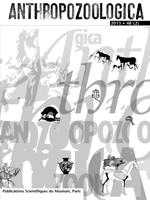Animal remains have been excavated in many Mesolithic burials. A large variety of skeletal and body parts (e.g. antlers, claws, hoofs, horns, long bones, mandibles, paws, skulls, tails and vertebrae) from different mammals were interred with the deceased. In addition, beaks, wings and long bones from birds, as well as teeth and lower jaws of fish were found. Vertebrae of snakes, carapaces of pond turtles and femora of amphibians, as well as opened and unopened mollusc shells were likewise included in burial inventories. On occasion, complete animals (dogs — Canis familiaris —, pigs, fawn, fish) or a fish soup were placed with the dead or in pits next to the grave. Animal finds could have been remains of sacrificial food offerings to the dead, raw material for items in the afterlife or left-overs from the funeral feast. Animal teeth, mollusc shells and, occasionally, vertebrae of fish were used in jewellery and to decorate clothing. Certain bones or body parts may have been amulets or items with a special ritual meaning. Mandibles of wild pigs (Sus scrofa) and red deer (Cervus elaphus) were deposited in ritual fire places above the graves. Antlers could have been used in the burial structure and possibly also as part of shamans' masks. The largest variety of items was found in cemeteries. Animal remains were more frequently excavated from double and group burials, than from single graves. The aim of this paper is to summarize the data of more than 200 burial sites and discuss the possible function of animal remains in Mesolithic burials.
How to translate text using browser tools
1 December 2013
Animals in Mesolithic Burials in Europe
Judith M. Grünberg
ACCESS THE FULL ARTICLE
It is not available for individual sale.
This article is only available to subscribers.
It is not available for individual sale.
It is not available for individual sale.

Anthropozoologica
Vol. 48 • No. 2
December 2013
Vol. 48 • No. 2
December 2013
animal remains
burials
Europe
food offerings
funerary rites
grave goods
MESOLITHIC




